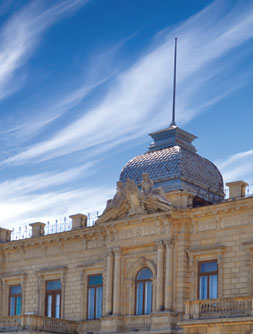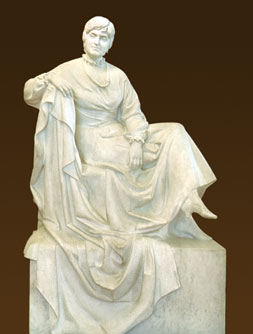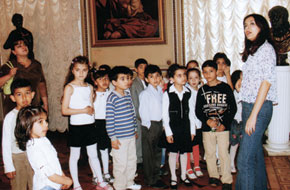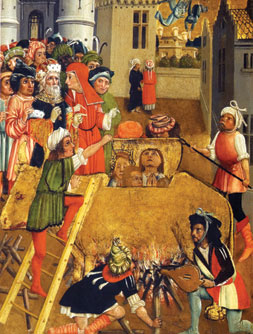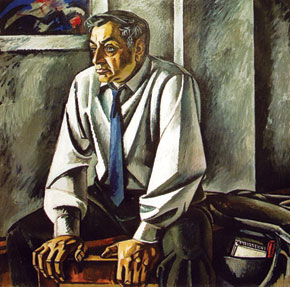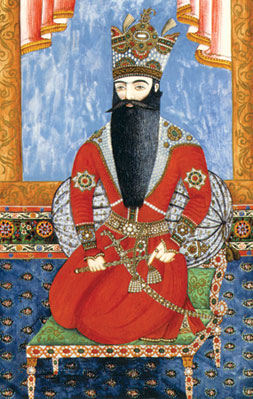Pages 74-81
by Ziyadkhan Aliyev
Just one visit to the nation’s spiritual treasure-house, otherwise known as the Rustam Mustafayev Azerbaijani State Museum of Art, will confirm that the Land of Fire has much more than its ‘black gold’. The art works displayed in the museum, forming a spiritual bridge across the centuries, provide ample evidence. But how was the museum founded? How was this enchanting collection assembled? To answer these natural questions we would like to transport you back nearly one hundred years…
Finding a home…
Although art works had been on display in a separate section of the Azerbaijani State Museum, founded after the occupation by Soviet Russia in 1920, it was soon clear to all that this was totally inadequate. Most sections of the museum in Baku appeared small and insignificant to those who travelled to other major cities of the USSR. Even though works by Western European and Russian-Soviet painters and sculptors were sent to Baku from the central museum collections of Moscow and St. Petersburg from the mid 1920s, there were no suitable facilities or venues to display them. In view of the natural demand from the city population and its many visitors, in 1936 the government decided to found a separate art museum in Baku. The exposition was opened to visitors one year later. However, it had not been possible to find a separate building for the new museum and it began life as a lessee in the building which is now the Nizami National Museum of Azerbaijani Literature. People’s painter Kazim Kazimzade who headed the Azerbaijani State Museum of Art from 1942 for the remaining 50 years of his life, said that this continued until 1951. By then a new administrative building had been constructed for the Cabinet and the premises at 9 Niyazi Street were emptied. It was then a question of handing over the building either to the Headquarters staff or to the Museum of Art. First Secretary of the Azerbaijani Communist Party Mir Jafar Baghirov decided to dedicate it to the arts. Thus, this marvellous architectural building (the architect was civil engineer and later mayor of Baku, Nikolaus von der Nonne) was allocated to the Museum.
In 1943 the museum was named after Rustam Mustafayev, an artist and theatre set designer who died in 1940, aged only 30. In its new setting, it became the main centre for both locals and visitors to view the history of Azerbaijani art. However, by 1992 even this grand building was too small for the museum’s growing treasury of both World and Azerbaijani art. The collection had been considerably enriched and comprised more than fifteen thousand works. The answer to this problem lay close at hand, next door in fact. The neighbouring three-storey building was of similar design and so the museum expanded shortly after the country regained its independence. As oil wealth accrued, President Ilham Aliyev signed an order, in 2006, to improve the work and condition of museums. The Museum of Art recently underwent thorough repair and material and technical resources have been updated. The effect has been a significant improvement in visitors’ experience of the art works, with the museum’s interiors now providing a much higher level of comfort and aesthetic appearance. Thus the viewer can concentrate on the spiritual energy emanating from the works of great artists…
… And furnishing it
Of course a museum’s main appeal is its display. Connoisseurs of true art are always willing to go that little bit further to get face to face with the best work. The 75 year-old Azerbaijani State Museum of Art has a plentiful supply of such gems. Although it has been collecting since it was part of the Azerbaijani State Museum, most of the works have been acquired since their separation in 1936. Many were paintings and sculptures, as well as examples of valuable decorative and applied arts, seized from Baku’s oil millionaires following the Soviet takeover. They include works by Western European and Russian painters belonging to the oil magnate and philanthropist Haji Zeynalbdin Tagiyev. While the country was part of the USSR, the collection was significantly enhanced by items obtained from various sources within the Union: the State Hermitage Museum, the State Tretyakov Gallery, the Pushkin State Museum of Fine Arts and the State Museum of Oriental Art among others. In addition, the standing purchase commission periodically buys valuable art works offered to it.
The treasure trove inside, crafts…
The Azerbaijani Art section of the museum is rich in items of jewellery, carpet weaving and ceramics, folk embroidery and national costumes, as well as skilfully made musical instruments, weapons, examples of ancient and modern decorative and applied arts, tombstones and gravestones with geometric patterns discovered during archaeological excavations. There are also works that hold within them the light in the eyes and the warmth of the hands of contemporary painters, sculptors and practitioners of other art forms…
The particular Azerbaijani imagination is well represented, even back to the most ancient of artistic traditions in the famous rock paintings of Gobustan. Those who are not able to visit Sheki, known as the land of craftsmen, may contemplate copies of the wall paintings which decorate the famous Palace of the Sheki khans and assure themselves of the incomparable skills of such masters as Usta Ganbar Karabakhli, Ali Gulu and Gurban Ali, who created the originals.
Traces of ancient historical and cultural life in Azerbaijan are found especially in the decorative and applied arts. Thus, folk craftsmen using wood, clay, stone etc. created items connected with their life style and daily lives and produced at the same time delightful and marvellous samples of art. These items retain their high artistic value and embellish the Museum of Art. There are household goods from the 6-4 millennia B.C., discovered during archaeological excavations in Mingechevir and Goygol (the former Khanlar): enamels, bronzes, and copper items from the 11th-19th centuries. Pile and pileless carpets woven in the great centres of carpet making Quba, Tabriz, Baku, Shirvan, Karabakh and Qazakh, samples of filigree jewellery, embossing, carving, original copper vessels and more are all on display.
These works immortalize the artistic styles and traditions through the ages to the present. They are also reliable sources for studying the development of the nation’s spiritual values.
It is natural that those who have seen the fabulous craftsmanship of Azerbaijani carpet weavers in the famous Sheikh Safi (or Ardebil) carpet exhibited in London’s Victoria and Albert Museum wish to see similar miracles of the art in a Baku museum. The age-old tradition of Azerbaijani carpet weaving, still continued, is seen in the miniature works of Tabriz craftsmen, as well as in paintings by Western European artists. The vivid colouring and wonderful patterns of carpets with themes like ‘Four seasons’, ‘Dervishes’ and ‘Hunting’, as well as Pirebedil, Shamakha and Bahar (Spring) are simply enchanting. The carpets’ names usually indicate their origin.
The embroidery exhibited in the museum provides evidence to support the praise lavished on it by Alexandre Dumas père. In his travelling notes Voyage au Caucase, Dumas tells of his meeting with the poetess Khurshud Banu Natavan in Azerbaijan; some of her embroidery was among the souvenirs he took with him to Paris. The fine intricacy of Gush gozu (Bird’s eye), Qurama (patchwork) etc. was used in the making of decorative costumes, curtains, throws, tablecloths, pillows, mutakka (long tubular pillows), women’s shoes, seal holders and the Qur’an, prayer rugs, tobacco pouches and other items.
…and paintings
The exhibits cover the whole period of development of the visual arts in Azerbaijan, from rock paintings onwards. There is, too, broad geographical coverage, with paintings and graphics from Tabriz, Irevan, Istanbul, Shusha, Sheki, Baku and many other places. The works of Mirza Gadim Irevani (1825-75) are particularly interesting. His paintings used to adorn the Sardar Palace of the Irevan khans (this fabulous monument was a fine example of the synthesis of painting and architecture, but it was destroyed by Armenian Dashnaks in the early 20th century). Mirza Gadim Irevani’s paintings of historical personalities (Fatali shah, the Gajar Prince Majulla Mirza) and his contemporaries are a specific and attractive conjunction of the Gajar Style, widespread in the 18th and 19th centuries, and the principles of realism brought from Europe and Russia to Azerbaijan.
We would not be in error to declare that works by the eminent Azerbaijan intellectual, and creator of idea of the three-colour flag of the Azerbaijan Democratic Republic Ali bey Huseynzade add considerably to information about the state of the visual arts of 20th century Azerbaijan. Huseynzade was forced to live an emigrant’s life in Turkey, but his works (Bibiheybat Mosque, Portrait of the Sheik-ul-Islam) are on display in the museum. As are those of his son Muhammad Salim Turan, who lived and worked in Paris (Portrait of M.P.Vagif, Woman with a Pink Kerchief). Nakhchivani painters Ibrahim Safi (Portrait of Zarrukh khanim) and Akbar Kazim Mugan (Portrait of a Young Man) are also well worth a look.
Works reflecting the diversity of content and style of Bahruz Kengerli and Azim Azimzade, who are seen as the founders of realism in Azerbaijani art, are also available in the museum exposition.
In spite of the fact that 20th century Azerbaijani art developed mainly in the difficult conditions of the communist regime and socialist ideology, the national spirit and artistic traditions were continuously enriched by the paintings created. There were many artists who brought tradition and modernity to their work. The fascinating lyric and poetic landscapes (The Beauty of Khazar, Tears of Kapaz) of Sattar Bahlulzade, also known as The singer of Azerbaijani nature, the romantic spirit of Tahir Salahov, who made his mark as the creator of the strict style artistic current (Repairmen, Portrait of Rasul Rza), the graphic paintings of Togrul Narimanbeyov who turned national values into artistic sets (Mugam, Baku), as well as the graphic paintings of Alekber Rzaguliyev devoted to old Baku; sculptures by Omar Eldarov, T.Mammadov and F.Salayev are also remarkable display items.
The European aesthetic
Although the State Museum of Art’s collection of works by eminent Western European painters cannot compete with the world’s most famous museums (some of the most prestigious works are represented by old reproductions), any museum might envy the most valued works held here. These include paintings by the Dutch Frans Hals and Adriaen van Ostade, the Flemish Justus Sustermans, Adriaen Brouwer, David Teniers, Pieter Claesz and the Frenchman Jules Dupré. It should be added that the Baku museum was unique in the USSR in exhibiting two of Jules Dupré’s best works. He was a representative of the Barbizon school which marked the beginning of fundamental change in European painting in the second half of the 19th century.
The various schools of Italian painting are represented in the collection, with paintings by Leonardo Bassano, Giovanni Guercino, Bartolomeo Schedone, Francesco Solimena and sculpture by Lorenzo Bartolini.
Among the numerous examples of German art, the portrait of Alexandra Fyodorovna, consort of Tsar Nicholas II, painted by Friedrich August von Kaulbach has clear historical and artistic significance. Fabulous items from the Meissen porcelain factory are also valuable constituents of the museum’s display.
Although Italy, Flanders, Holland and Spain were famed for their painting and sculpture, France was in the ascendant in the 17th-19th. Gravures (works by Gaspard Dughet and Benjamin Constant) displayed in the Baku Museum confirm this…
The Russian-Soviet collection
The Russian and Soviet paintings are all the original creations of the artists. Among those held are: Portrait of a Woman by A. Ivanov, who is famous for his large canvas Resurrection of Jesus; Portrait of Pashkov by K.Bryullov, well-known for his Last Day of Pompey; “Friendly Fathers-in-law” by Vereshchagin, who philosophised on the horrors of war in his Apotheosis of War; Vereshchagin’s View of Baku from the Sea depicts 19thcentury Baku; Breakup of a Marriage by V.Pukirev, the painter of the psychological Russian bride (Mesalliance); and images on glass created by the world famous Wassily Kandinsky.
The Russian avant-garde artists highly appreciated by art connoisseurs as pioneers of artistic advance at the turn of the 19th and 20th centuries are well-represented, too. Visitors to the museum can assess the artistic and aesthetic qualities of the Russian avant-garde in various works by Kandinsky, Malevich, El Lissitzky, Larionov and Goncharova. Pictures by Mashkov and Lentulov, who used various styles in the early 20th century, are attractive insights into the exciting artistic and aesthetic currents of the time…
Afterword
The antiquity of Azerbaijani culture and the richness of its art is clear from the chronological arrangement of its exposition - as is the respect for the cultures of other nations. The Rustam Mustafayev State Museum of Art is rightly proud of the cultural wealth it holds on behalf of the nation. Just a few hours in the museum reveals the care lavished by today’s generation in protecting the artistic traditions of their ancestors and creative contemporaries. They enjoy the art of other nations as well as their own. Nations which forget their own traditions and spiritual foundations can easily lose their identity and disappear...
by Ziyadkhan Aliyev
Just one visit to the nation’s spiritual treasure-house, otherwise known as the Rustam Mustafayev Azerbaijani State Museum of Art, will confirm that the Land of Fire has much more than its ‘black gold’. The art works displayed in the museum, forming a spiritual bridge across the centuries, provide ample evidence. But how was the museum founded? How was this enchanting collection assembled? To answer these natural questions we would like to transport you back nearly one hundred years…
Finding a home…
Although art works had been on display in a separate section of the Azerbaijani State Museum, founded after the occupation by Soviet Russia in 1920, it was soon clear to all that this was totally inadequate. Most sections of the museum in Baku appeared small and insignificant to those who travelled to other major cities of the USSR. Even though works by Western European and Russian-Soviet painters and sculptors were sent to Baku from the central museum collections of Moscow and St. Petersburg from the mid 1920s, there were no suitable facilities or venues to display them. In view of the natural demand from the city population and its many visitors, in 1936 the government decided to found a separate art museum in Baku. The exposition was opened to visitors one year later. However, it had not been possible to find a separate building for the new museum and it began life as a lessee in the building which is now the Nizami National Museum of Azerbaijani Literature. People’s painter Kazim Kazimzade who headed the Azerbaijani State Museum of Art from 1942 for the remaining 50 years of his life, said that this continued until 1951. By then a new administrative building had been constructed for the Cabinet and the premises at 9 Niyazi Street were emptied. It was then a question of handing over the building either to the Headquarters staff or to the Museum of Art. First Secretary of the Azerbaijani Communist Party Mir Jafar Baghirov decided to dedicate it to the arts. Thus, this marvellous architectural building (the architect was civil engineer and later mayor of Baku, Nikolaus von der Nonne) was allocated to the Museum.
In 1943 the museum was named after Rustam Mustafayev, an artist and theatre set designer who died in 1940, aged only 30. In its new setting, it became the main centre for both locals and visitors to view the history of Azerbaijani art. However, by 1992 even this grand building was too small for the museum’s growing treasury of both World and Azerbaijani art. The collection had been considerably enriched and comprised more than fifteen thousand works. The answer to this problem lay close at hand, next door in fact. The neighbouring three-storey building was of similar design and so the museum expanded shortly after the country regained its independence. As oil wealth accrued, President Ilham Aliyev signed an order, in 2006, to improve the work and condition of museums. The Museum of Art recently underwent thorough repair and material and technical resources have been updated. The effect has been a significant improvement in visitors’ experience of the art works, with the museum’s interiors now providing a much higher level of comfort and aesthetic appearance. Thus the viewer can concentrate on the spiritual energy emanating from the works of great artists…
… And furnishing it
Of course a museum’s main appeal is its display. Connoisseurs of true art are always willing to go that little bit further to get face to face with the best work. The 75 year-old Azerbaijani State Museum of Art has a plentiful supply of such gems. Although it has been collecting since it was part of the Azerbaijani State Museum, most of the works have been acquired since their separation in 1936. Many were paintings and sculptures, as well as examples of valuable decorative and applied arts, seized from Baku’s oil millionaires following the Soviet takeover. They include works by Western European and Russian painters belonging to the oil magnate and philanthropist Haji Zeynalbdin Tagiyev. While the country was part of the USSR, the collection was significantly enhanced by items obtained from various sources within the Union: the State Hermitage Museum, the State Tretyakov Gallery, the Pushkin State Museum of Fine Arts and the State Museum of Oriental Art among others. In addition, the standing purchase commission periodically buys valuable art works offered to it.
The treasure trove inside, crafts…
The Azerbaijani Art section of the museum is rich in items of jewellery, carpet weaving and ceramics, folk embroidery and national costumes, as well as skilfully made musical instruments, weapons, examples of ancient and modern decorative and applied arts, tombstones and gravestones with geometric patterns discovered during archaeological excavations. There are also works that hold within them the light in the eyes and the warmth of the hands of contemporary painters, sculptors and practitioners of other art forms…
The particular Azerbaijani imagination is well represented, even back to the most ancient of artistic traditions in the famous rock paintings of Gobustan. Those who are not able to visit Sheki, known as the land of craftsmen, may contemplate copies of the wall paintings which decorate the famous Palace of the Sheki khans and assure themselves of the incomparable skills of such masters as Usta Ganbar Karabakhli, Ali Gulu and Gurban Ali, who created the originals.
Traces of ancient historical and cultural life in Azerbaijan are found especially in the decorative and applied arts. Thus, folk craftsmen using wood, clay, stone etc. created items connected with their life style and daily lives and produced at the same time delightful and marvellous samples of art. These items retain their high artistic value and embellish the Museum of Art. There are household goods from the 6-4 millennia B.C., discovered during archaeological excavations in Mingechevir and Goygol (the former Khanlar): enamels, bronzes, and copper items from the 11th-19th centuries. Pile and pileless carpets woven in the great centres of carpet making Quba, Tabriz, Baku, Shirvan, Karabakh and Qazakh, samples of filigree jewellery, embossing, carving, original copper vessels and more are all on display.
These works immortalize the artistic styles and traditions through the ages to the present. They are also reliable sources for studying the development of the nation’s spiritual values.
It is natural that those who have seen the fabulous craftsmanship of Azerbaijani carpet weavers in the famous Sheikh Safi (or Ardebil) carpet exhibited in London’s Victoria and Albert Museum wish to see similar miracles of the art in a Baku museum. The age-old tradition of Azerbaijani carpet weaving, still continued, is seen in the miniature works of Tabriz craftsmen, as well as in paintings by Western European artists. The vivid colouring and wonderful patterns of carpets with themes like ‘Four seasons’, ‘Dervishes’ and ‘Hunting’, as well as Pirebedil, Shamakha and Bahar (Spring) are simply enchanting. The carpets’ names usually indicate their origin.
The embroidery exhibited in the museum provides evidence to support the praise lavished on it by Alexandre Dumas père. In his travelling notes Voyage au Caucase, Dumas tells of his meeting with the poetess Khurshud Banu Natavan in Azerbaijan; some of her embroidery was among the souvenirs he took with him to Paris. The fine intricacy of Gush gozu (Bird’s eye), Qurama (patchwork) etc. was used in the making of decorative costumes, curtains, throws, tablecloths, pillows, mutakka (long tubular pillows), women’s shoes, seal holders and the Qur’an, prayer rugs, tobacco pouches and other items.
…and paintings
The exhibits cover the whole period of development of the visual arts in Azerbaijan, from rock paintings onwards. There is, too, broad geographical coverage, with paintings and graphics from Tabriz, Irevan, Istanbul, Shusha, Sheki, Baku and many other places. The works of Mirza Gadim Irevani (1825-75) are particularly interesting. His paintings used to adorn the Sardar Palace of the Irevan khans (this fabulous monument was a fine example of the synthesis of painting and architecture, but it was destroyed by Armenian Dashnaks in the early 20th century). Mirza Gadim Irevani’s paintings of historical personalities (Fatali shah, the Gajar Prince Majulla Mirza) and his contemporaries are a specific and attractive conjunction of the Gajar Style, widespread in the 18th and 19th centuries, and the principles of realism brought from Europe and Russia to Azerbaijan.
We would not be in error to declare that works by the eminent Azerbaijan intellectual, and creator of idea of the three-colour flag of the Azerbaijan Democratic Republic Ali bey Huseynzade add considerably to information about the state of the visual arts of 20th century Azerbaijan. Huseynzade was forced to live an emigrant’s life in Turkey, but his works (Bibiheybat Mosque, Portrait of the Sheik-ul-Islam) are on display in the museum. As are those of his son Muhammad Salim Turan, who lived and worked in Paris (Portrait of M.P.Vagif, Woman with a Pink Kerchief). Nakhchivani painters Ibrahim Safi (Portrait of Zarrukh khanim) and Akbar Kazim Mugan (Portrait of a Young Man) are also well worth a look.
Works reflecting the diversity of content and style of Bahruz Kengerli and Azim Azimzade, who are seen as the founders of realism in Azerbaijani art, are also available in the museum exposition.
In spite of the fact that 20th century Azerbaijani art developed mainly in the difficult conditions of the communist regime and socialist ideology, the national spirit and artistic traditions were continuously enriched by the paintings created. There were many artists who brought tradition and modernity to their work. The fascinating lyric and poetic landscapes (The Beauty of Khazar, Tears of Kapaz) of Sattar Bahlulzade, also known as The singer of Azerbaijani nature, the romantic spirit of Tahir Salahov, who made his mark as the creator of the strict style artistic current (Repairmen, Portrait of Rasul Rza), the graphic paintings of Togrul Narimanbeyov who turned national values into artistic sets (Mugam, Baku), as well as the graphic paintings of Alekber Rzaguliyev devoted to old Baku; sculptures by Omar Eldarov, T.Mammadov and F.Salayev are also remarkable display items.
The European aesthetic
Although the State Museum of Art’s collection of works by eminent Western European painters cannot compete with the world’s most famous museums (some of the most prestigious works are represented by old reproductions), any museum might envy the most valued works held here. These include paintings by the Dutch Frans Hals and Adriaen van Ostade, the Flemish Justus Sustermans, Adriaen Brouwer, David Teniers, Pieter Claesz and the Frenchman Jules Dupré. It should be added that the Baku museum was unique in the USSR in exhibiting two of Jules Dupré’s best works. He was a representative of the Barbizon school which marked the beginning of fundamental change in European painting in the second half of the 19th century.
The various schools of Italian painting are represented in the collection, with paintings by Leonardo Bassano, Giovanni Guercino, Bartolomeo Schedone, Francesco Solimena and sculpture by Lorenzo Bartolini.
Among the numerous examples of German art, the portrait of Alexandra Fyodorovna, consort of Tsar Nicholas II, painted by Friedrich August von Kaulbach has clear historical and artistic significance. Fabulous items from the Meissen porcelain factory are also valuable constituents of the museum’s display.
Although Italy, Flanders, Holland and Spain were famed for their painting and sculpture, France was in the ascendant in the 17th-19th. Gravures (works by Gaspard Dughet and Benjamin Constant) displayed in the Baku Museum confirm this…
The Russian-Soviet collection
The Russian and Soviet paintings are all the original creations of the artists. Among those held are: Portrait of a Woman by A. Ivanov, who is famous for his large canvas Resurrection of Jesus; Portrait of Pashkov by K.Bryullov, well-known for his Last Day of Pompey; “Friendly Fathers-in-law” by Vereshchagin, who philosophised on the horrors of war in his Apotheosis of War; Vereshchagin’s View of Baku from the Sea depicts 19thcentury Baku; Breakup of a Marriage by V.Pukirev, the painter of the psychological Russian bride (Mesalliance); and images on glass created by the world famous Wassily Kandinsky.
The Russian avant-garde artists highly appreciated by art connoisseurs as pioneers of artistic advance at the turn of the 19th and 20th centuries are well-represented, too. Visitors to the museum can assess the artistic and aesthetic qualities of the Russian avant-garde in various works by Kandinsky, Malevich, El Lissitzky, Larionov and Goncharova. Pictures by Mashkov and Lentulov, who used various styles in the early 20th century, are attractive insights into the exciting artistic and aesthetic currents of the time…
Afterword
The antiquity of Azerbaijani culture and the richness of its art is clear from the chronological arrangement of its exposition - as is the respect for the cultures of other nations. The Rustam Mustafayev State Museum of Art is rightly proud of the cultural wealth it holds on behalf of the nation. Just a few hours in the museum reveals the care lavished by today’s generation in protecting the artistic traditions of their ancestors and creative contemporaries. They enjoy the art of other nations as well as their own. Nations which forget their own traditions and spiritual foundations can easily lose their identity and disappear...
